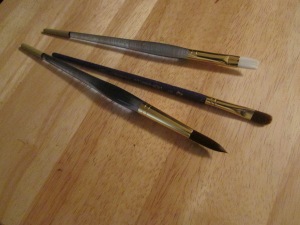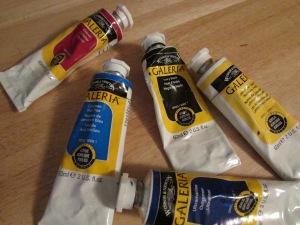Research: If you are a novice to painting, the easiest way to begin is to do your research. And one of the best places in which to do research is your local library. Check out some books on basic drawing and sketching techniques. In order to paint well, you will need some basic understanding of drawing techniques as acrylic painting follows a lot of the same techniques. Once you understand the basics of drawing and sketching, check out books on how to paint with acrylics.
Acrylic Paints: Acrylics are water-based and quick-drying. When acrylic paint dries, it becomes light-fast and permanent. Acrylic paint is water-soluble when wet, but water resistant when dry. Acrylic paints are vibrant when applied using translucent layering. If you would like to add texture to your painting, you can do so by mixing acrylic paints with gels or pastes. You can apply the paint thickly and get effects similar to oil paints, or you can thin the paint using water or medium and create striking results such as you would get with watercolors.
Color mixing: You will need to have an understanding of how colors are mixed in order to use acrylic paints effectively. Learning about color wheels is definitely on your to-do list. The primary colors on the color wheel are red, yellow, and blue. These colors cannot be mixed or formed from any combination of other colors. The secondary colors on the color wheel are formed by mixing red and yellow to create orange, by mixing yellow and blue to create green, and by mixing red and blue to create purple. The tertiary colors are formed by mixing a primary color with a secondary color. Knowing color wheel theory will help you learn how to mix colors for your paintings so that they will be rich and vibrant and not dull and drab.
Paint Grades: For beginners, start out using less-expensive grades of acrylic paints until you understand how they work. Paints can be expensive, so you want to choose a basic set of primary colors that can be mixed to create the secondary and tertiary colors on the color wheel. If you can afford to buy more colors, do so. As you develop your painting techniques, move on to professional-grade acrylic paints. Using high-quality paints will only make your work better. Learn about the different types of acrylic paints, the various manufacturers of those paints, and related products that can be used to make your acrylic paints work well.

Brushes: Synthetic brushes work best for acrylic paints. Stiff-bristled brushes are useful for applying paint thickly to the painting surface. Soft-bristled brushes are good for thin washes of color or thinned paint. Three types of brushes to start with are Rounds, Flats, and Filberts. Rounds are great because they have fine points for detailed work. For blocking in large areas of color, choose Flat brushes. Filberts are great for blending because they have a feathered top. They can also be used to block in areas of color and for detail work.
Palette: For a palette, choose a flat, plastic surface that is impervious to water since acrylic paint is often thinned with water. Choosing a palette with a lid or sealable compartments is great for keeping the acrylic paint from drying out between painting sessions.

Surfaces: There are many surfaces on which you can use acrylic paints: watercolor paper, canvas boards, stretched canvas, MDF, hardboard, and plywood panels, leather, and many other surfaces. Paper supports can be used if they have been properly sized with a gesso or primer. The surface of the paper must be sized before acrylic paint can be applied. If the surface is not sized, the acrylic paint will sink into the fibers of the paper surface and become dull and muddied.
Water Containers: You will need a container of water to rinse your brushes between brush strokes. Acrylic paint dries fast, so to ensure your brushes do not dry with the acrylic paint on them, you need to rinse them often. If you let acrylic paint dry on your brushes, they are basically ruined as dried acrylic paints are difficult to remove from paint brushes.
With a little knowledge of how to paint with acrylics, you can be well on your way to becoming the artist you know you can be. Start doing your research now, and in no time you will be putting out those masterpieces lurking within you.
.
To receive detailed views of my paintings, sign in below (IT'S FREE). Your email will never be shared.
.

No comments:
Post a Comment